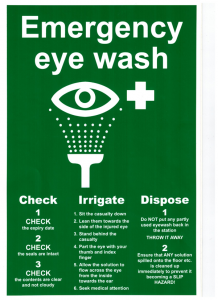Module 1: Laboratory safety
Module 1.1: General Laboratory Safety
General laboratory safety
We are working with BSL-2 designated samples that may have zoonotic potential along with potentially harmful chemicals, thus it is important to:
- Place book bags under benchtop in plastic bins
- Avoid clutter on your benchtop
- No eating or drinking in the lab
- Wear all appropriate PPE (personal protective equipment)
- Goggles are available for those that would like eye protection
- Wash your hands after lab
- Clean up spills immediately
- Long hair should be tied back
- Must wear close-toed shoes
- If you are pregnant or planning on becoming pregnant, please let an instructor know so that we can get you fitted with the appropriate PPE
Benchtop safety
Each benchtop has a stainless-steel metal tray that contains the following items:
- microbiology stains
- heat sterilizer
- microbiology loops
- flammable liquids
- miscellaneous laboratory items
All experiments are to be performed and conducted in or over this tray. Not on the black benchtop.
The tray is to protect you and contain biohazardous material, breakables, and chemicals in a small area in the case of a spill or glassware break. Please keep workbooks, laptops, iPad, tablets, or anything but your experiment, out of this area, and on the black benchtop or stored in the plastic bins under your benchtop.
Centrifuge safety
The centrifuge is a commonly used tool in our laboratory. It uses centrifugal force to separate substances in liquid or solid media according to particle size and density differences. Centrifugation may present two serious hazards: mechanical failure and dispersion of aerosols. Therefore, training on how to use the centrifuge properly and safely is essential for all individuals as part of Lab-Specific Training.
Safe Procedures for Centrifugation
Before centrifugation
- Train each operator on proper operating procedures
- The following steps are taken care of by our laboratory staff
- Use only rotors compatible with the centrifuge. Check the expiration date for ultracentrifuge rotors.
- Check tubes, bottles, and rotors for cracks and deformities before each use.
- Make sure that the rotor, tubes, and spindle are dry and clean.
- Examine O-rings and replace if worn, cracked, or missing.
- When you (student) are using the centrifuges
- Never overfill centrifuge tubes (don’t exceed ¾ full).
- Always cap tubes before centrifugation.
- Always balance buckets, tubes, and rotors properly.
- Check that the rotor is seated on the drive correctly, close the lid on the centrifuge, and secure it.
During centrifugation
- Keep the lid closed at all times during operation. Never open a centrifuge until the rotor has stopped.
- Do not exceed safe rotor speed.
- The operator should not leave the centrifuge until full operating speed is attained and the machine appears to be running safely without vibration.
- Stop the centrifuge immediately if an unusual condition (noise or vibration) begins and check load balances.
After centrifugation
- Allow the centrifuge to come to a complete stop before opening.
- Wear gloves to remove rotor and samples.
- Check inside of centrifuge for possible spills and leaks, clean centrifuge and rotor thoroughly if necessary.
- Wash hands after removing gloves.
Centrifuging Infectious Materials
Follow the safety procedures above, plus:
- Always wear gloves when handling tubes or rotors.
- Always use sealed safety cups, safety buckets, or sealed rotors with )-ring as secondary containment if available.
- Fill centrifuge tubes, load into rotors, remove from rotors, and open tubes within a biological safety cabinet if biological safety cabinet is available.
- Wipe exterior of tubes or bottles with disinfectant prior to loading into rotor or bucket. Seal rotor or bucket, remove outer gloves, and transport to the centrifuge.
- Always wait at least 10 minutes after the run to allow aerosols to settle before opening the centrifuge. Check for possible spills or leaks. For spills of infectious materials, see Centrifuge Emergency Procedures.
- Decontaminate centrifuge interior, safety cups or buckets, and rotors if tube breakage occurs. See Centrifuge Emergency Procedures.
- Include centrifugation procedure and decontamination plan in lab SOPs.
Centrifuge safety follows the UMN Biosaefty and occupational health protocols: Please follow this link for more information.
Safety equipment
Fire extinguishers, eyewashes, and showers are located throughout the classroom (VSB 325 and AS/VM 104). Please familiarize yourself with their location in the laboratories. They are denoted by the green banners as shown below.

Material safety data sheets
As a student, you have a right to know any information about the safety and risks of exposure for any chemical used or accessible in the laboratory. Material Safety Data Sheets (MSDS) are available for your review if you have a concern or questions, feel free to contact the instructor (Dr. Burton).

